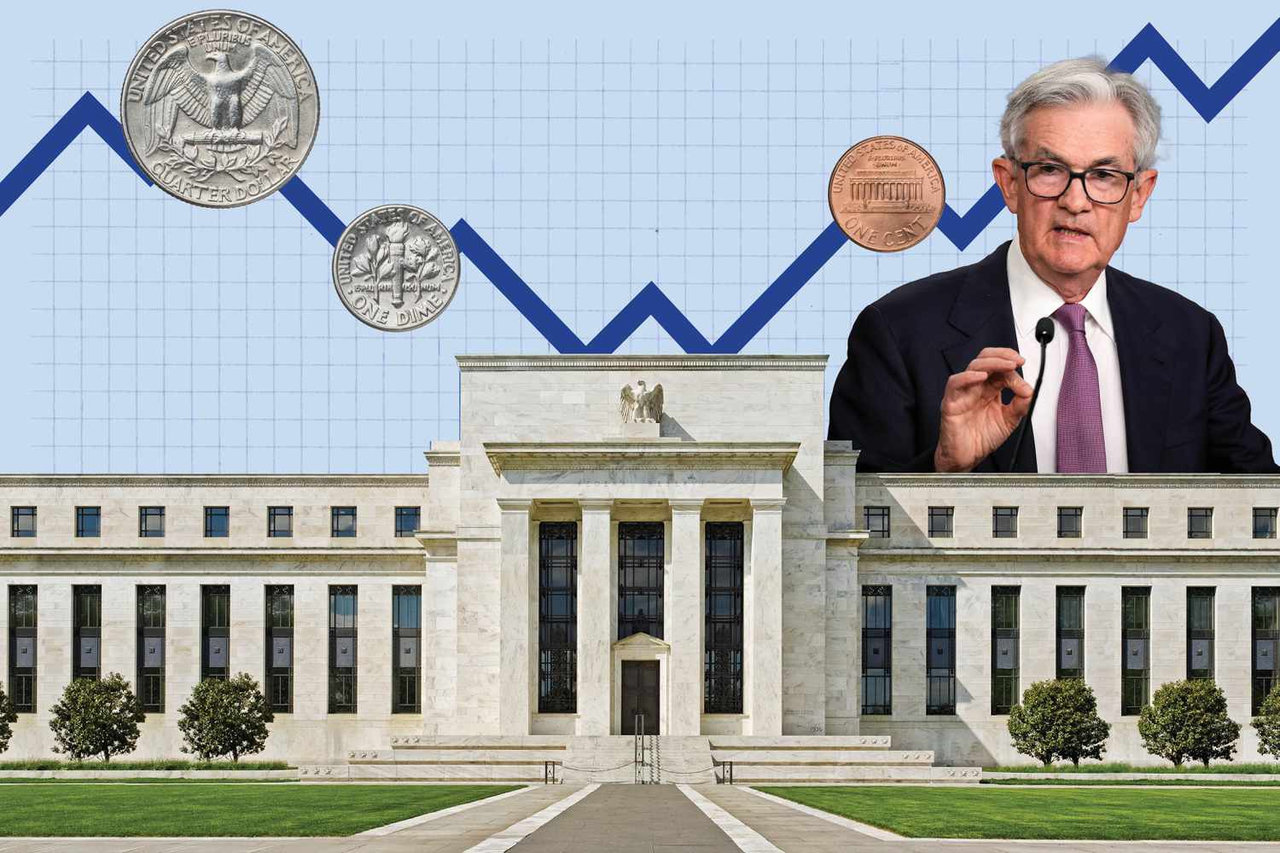The Fed Lowered Rates: What That Means for Your Crypto Portfolio?
The financial world was bracing for the Federal Reserve's latest decision, which, as expected, delivered a 25-basis-point interest rate cut on Oct. 30th.

Key Takeaways
- Powell's "hawkish" warning immediately shattered market confidence, proving the market had overpriced the certainty of continuous rate cuts.
- The Fed’s rare internal split (hawk-dove dissent) exposes policy ambiguity, directly translating into external volatility for risk assets.
- The synchronized fall of Bitcoin below $110,000 confirms that rate uncertainty is amplifying risk aversion, forcing traders into a cautious "wait-and-see" mode.
The financial world was bracing for the Federal Reserve's latest decision, which, as expected, delivered a 25-basis-point interest rate cut on Oct. 30th. Ordinarily, a rate cut—which signals looser money and cheaper borrowing—should send assets like Bitcoin and Ethereum soaring.
However, the opposite happened. Global markets, including major U.S. indices and the entire crypto complex, experienced a sharp tumble. The problem wasn't the decision itself; it was the message. Fed Chair Jerome Powell’s accompanying remarks sent a surprisingly "hawkish" signal, crushing the market's optimistic hopes for continued, easy rate cuts in the future.
This article breaks down the two crucial signals the Fed just sent, why they are creating dangerous uncertainty, and what it means for the market's direction heading into the end of the year.
The Macro Disagreement and Policy Ambiguity
The market's immediate negative reaction stemmed from a crucial vulnerability: the significant lack of consensus within the Federal Reserve itself. This internal strife signals policy ambiguity, which global investors universally dislike.
The Rare "Hawk-Dove" Split
The official Federal Open Market Committee (FOMC) statement revealed a rare "hawk-dove" split among its board members—a sign of deep internal disagreement over the economic outlook.
- Internal Dissent: The meeting saw governors with diametrically opposed views: one advocated for a more aggressive 50-basis-point cut, while another firmly opposed any rate cut, advocating for maintaining the status quo.
- Significance: This stark dual dissent—a phenomenon rarely observed—highlights that the Fed lacks a clear, unified view on the correct path forward. This lack of unity immediately increases perceived risk across all asset classes.
Ambiguity on Future Cuts and QT's End
This internal disagreement creates intense uncertainty about the December meeting, severely shaking the market’s certainty:
- Questioning December: Market predictions for a subsequent 25 basis point cut in December immediately plummeted, as Powell's remarks confirmed that further cuts are "far from" a done deal.
- Balance Sheet Management: The Fed announced the end of its balance sheet reduction (Quantitative Tightening, or QT) on December 1st. While the end of QT is generally seen as a long-term "dovish" signal (loosening financial conditions), the market's immediate fear of rate uncertainty completely overshadowed this long-term positive.
The ultimate effect of this macro disagreement is clear: the Fed’s internal uncertainty is immediately translated into external market volatility, forcing investors to adopt a cautious "wait-and-see" approach.
Powell's Warning Crushed Hopes for an Easy December Rate Cut
Despite delivering the highly anticipated rate cut, Fed Chair Jerome Powell’s accompanying press conference instantly contained key messages that the market interpreted as surprisingly "hawkish" (cautious). This unexpected shift in tone was the immediate cause of the synchronized asset sell-off.
The Inflation and Jobs Double-Bind
Powell effectively shattered the market's certainty about future cuts by stressing two fundamental points:
- Inflation Remains High: He emphasized that while existing data showed the U.S. economy was expanding at a moderate pace, inflation levels remained slightly too high. He confirmed the Fed has a responsibility to ensure inflation does not become a persistent problem.
- Labor Market Resilience: Powell noted that the labor market, while "gradually cooling," was still robust. He indicated that stronger employment data in the coming weeks would directly influence the Fed’s future decisions.
The Impact of Lost Certainty
This messaging immediately forced a structural repricing of risk. Investors heard a clear warning: the Fed feels obligated to cut rates to support employment, but the fight against inflation is not over. Powell explicitly stated that a December rate cut was "far from" a done deal, indicating the Fed is prioritizing caution over stimulus. This sudden withdrawal of certainty regarding future rate cuts immediately translates into volatility across risk assets, including your crypto portfolio.
Crypto Market Outlook: Navigating the Uncertainty and Risk Assets
The immediate market reaction to the Fed's announcement was dramatic, proving that the market is acutely sensitive to the removal of certainties. Following Powell's remarks, we saw a synchronized shift:
- Crypto and Stocks Tumble: Risk assets plummeted instantly. Bitcoin's price, which was trading higher, suddenly reversed and fell below the key $110,000 psychological support level. Stocks also suffered a sharp tumble.
- Dollar Strength: This risk-off move was confirmed by a strong surge in the U.S. dollar, as global capital sought safety.
The key uncertainty is now the path forward for risk assets like Bitcoin and Ethereum. The market had already priced in continuous cuts, and with that certainty shaken, traders are forced to aggressively hedge against downside risk. This ambiguity keeps risk appetite suppressed, and the market remains highly volatile until the Fed provides a definitive signal.
Risk Re-evaluation and Capital Flow
The Fed's caution forces a fundamental risk re-evaluation for capital managers:
- The Search for Safe Harbors: The sudden rise of the U.S. dollar (DXY) signals a flight to safety, putting pressure on BTC and ETH. Capital that flowed into risk assets expecting easy money is now pulling back.
- The Yield Advantage Erosion: The Fed's signaling of higher-for-longer rates (or uncertainty about future cuts) challenges the competitive advantage of crypto yields (e.g., DeFi and staking). If traditional short-term Treasury yields remain high due to inflation fears, the allure of crypto returns is eroded, demanding that protocols generate even higher APRs to compete for institutional funds.
The Path Forward for the Portfolio
The market is now in a "wait-and-see" mode. For the crypto portfolio, the message is clear: the era of easy money is being questioned, demanding a heightened focus on disciplined risk management. The next directional move will be determined by either unforeseen institutional inflows (countering the caution) or a definitive shift in the Fed's labor market outlook. Until then, risk is amplified, and caution prevails.
Cwallet: Your Gateway to a New Era of Crypto Finance
The world of cryptocurrency moves fast, but managing your assets can be simple and secure!Cwallet gives you an intuitive, powerful crypto wallet to store, swap, earn, and spend over 1,000 cryptocurrencies across 60+ blockchains — all in one app.
Your assets, your control: With the Cozy Card, one of the most secure crypto wallet payment solutions, your digital assets gain real-world spending power, either online or offline.
Your trades, your way: From zero-fee Memecoins and xStocks to exciting, interactive crypto trading experiences like Trend Trade and Market Battle, making every trade easier and more enjoyable.
Your time, your efficiency: With practical tools like HR Management, Mobile Refills, and Gift Cards, skip the hassle and focus on what matters most.
Join millions of users and redefine how you interact with crypto.
Official Link
Official Site: https://cwallet.com
Twitter: https://twitter.com/CwalletOfficial
Disclaimer
This content is strictly for informational and educational purposes only. It does not constitute financial, investment, legal, or tax advice, nor is it an offer or solicitation to buy, sell, or hold any digital asset. Crypto assets involve high volatility and risks, and their value can fluctuate greatly. Readers must be aware of and adhere to the relevant local laws and regulations concerning digital assets in their specific jurisdiction, as product availability may vary. All investment decisions must be based on your own research (DYOR) and risk assessment. Some content herein may be generated or assisted by artificial intelligence (AI) tools. The author and platform assume no liability for investment losses.
